

|
|
Δείτε εδώ τα πιο πρόσφατα μηνύματα από όλες τις περιοχές συζητήσεων, καθώς και όλες τις υπηρεσίες της AcroBase. H εγγραφή σας είναι γρήγορη και εύκολη. |
|
|||||||
Κεντρική σελίδα |
Λίστα Μελών | Games | Σημειώστε όλα τα forums ως διαβασμένα | Σημειώστε όλα τα forums ως διαβασμένα |
|
 |
|
|
Εργαλεία Θεμάτων | Τρόποι εμφάνισης |
 |
#226
|
 |
|
||||
 Building Galaxies in the Early Universe Credit: NASA, ESA, and N. Pirzkal (STScI/ESA) et al. Explanation: What was the very early universe like? To help find out, astronomers pointed the Hubble Space Telescope between bright nearby objects to create one of the deepest images ever -- the Hubble Ultra Deep Field (HUDF). The resulting HUDF is like a jewel box of strange and distant galaxies. A recent analysis of the HUDF focused on the smallest, faintest and most compact galaxies imaged. These small galaxies are thought to be the building blocks of modern galaxies. Analysis shows that these small galaxies are indeed themselves frequently merging to form large galaxies. An image of this field with the Spitzer Space Telescope shows a lack of infrared emission that would be expected from old stars, indicating that these small galaxies are very young, possibly only a few million years old. Therefore the young blue stars might be members of the first-ever generation of stars. Part of the HUDF is shown above, while one blue building-block galaxy, highly redshifted by the universe so as to appear more yellow, is shown in the upper left inset. Tomorrow's picture: scorpio sparkling Πηγή
__________________
όταν γράφεται η ιστορία της ζωής σου, μην αφήνεις κανέναν να κρατάει την πένα |
 |
#227
|
 |
|
||||
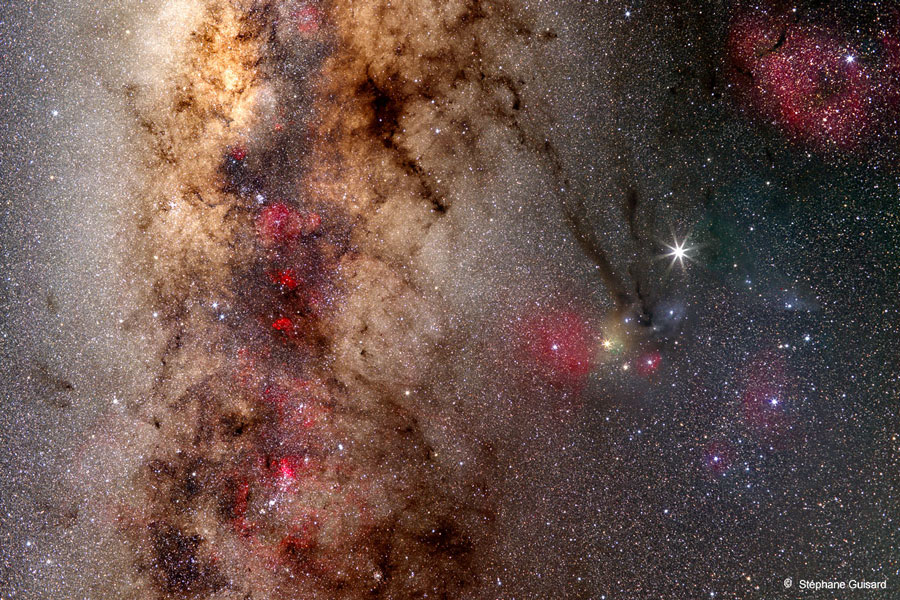 Κλικ για μεγέθινση A Scorpio Sky Spectacular Credit & Copyright: Stéphane Guisard Explanation: If Scorpio looked this good to the unaided eye, humans might remember it better. Scorpio more typically appears as a few bright stars in a well known but rarely pointed out zodiacal constellation. To get a spectacular image like this, though, one needs a good camera, color filters, and a digital image processor. To bring out detail, the above image not only involved long duration exposures taken in several colors, but one exposure in a very specific red color emitted by hydrogen that brings out great detail. The resulting image shows many breathtaking features. Vertically across the image left is part of the plane of our Milky Way Galaxy. Visible there are vast clouds of bright stars and long filaments of dark dust. Jutting out diagonally from the Milky Way in the image center are dark dust bands known as the Dark River. This river connects to several bright stars on the right that are part of Scorpio's head and claws, and include the bright star Antares. Numerous red emission nebulas and blue reflection nebulas are visible throughout the image. Scorpio appears prominently in southern skies after sunset during the middle of the year. Tomorrow's picture: six rainbows Πηγή
__________________
όταν γράφεται η ιστορία της ζωής σου, μην αφήνεις κανέναν να κρατάει την πένα |
 |
#228
|
 |
|
||||
 Κάντε κλικ για να δείτε την εντυπωσιακή αυτή φωτογραφία σε μεγάλο μέγεθος Six Rainbows Across Norway Credit & Copyright: Terje O. Nordvik Explanation: Have you ever seen six rainbows at once? They are not only rare to see -- they are a puzzle to understand. The common rainbow is caused by sunlight internally reflected by the backs of falling raindrops, while also being refracted at the air / water boundary. To see a rainbow, look opposite the Sun towards a rainstorm. This primary rainbow is the brightest color swath in the above image. Multiple internal reflections inside water droplets sometimes make a secondary rainbow to become visible outside the first, with colors reversed. Just such a secondary rainbow is visible of the far left. Harder to explain is the intermediate rainbow, between the two. This rainbow is likely caused by sunlight that has first reflected off the lake before striking the distant raindrops that is reflecting sunlight back toward the observer. Each of these rainbows appears to be reflected by the calm lake, although because the positions of rainbows depend on the location of the observer, a slightly displaced image of each rainbow is actually being imaged. Tomorrow's picture: open space Πηγή
__________________
όταν γράφεται η ιστορία της ζωής σου, μην αφήνεις κανέναν να κρατάει την πένα |
 |
#229
|
 |
|
||||
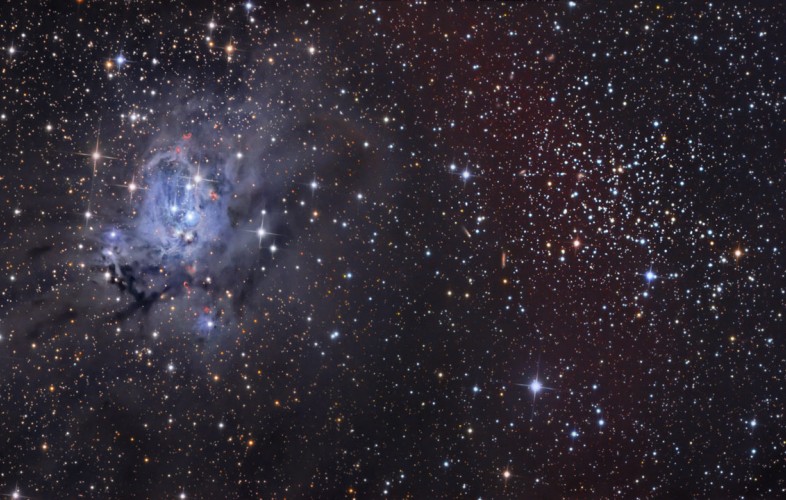 Κλικ για μεγέθυνση NGC 7129 and NGC 7142 Credit & Copyright: Tony Hallas Explanation: This alluring telescopic image looks toward the constellation Cepheus and an intriguing visual pairing of dusty reflection nebula NGC 7129 (left) and open star cluster NGC 7142. The two appear separated by only half a degree on the sky, but they actually lie at quite different distances. In the foreground, dusty nebula NGC 7129 is about 3,000 light-years distant, while open cluster NGC 7142 is likely over 6,000 light-years away. In fact, the pervasive and clumpy foreground dust clouds in this region redden the light from NGC 7142, complicating astronomical studies of the cluster. Still, NGC 7142 is thought to be an older open star cluster, while the bright stars embedded in NGC 7129 are perhaps a million years young. The telltale reddish crescent shapes around NGC 7129 are associated with energetic jets streaming away from newborn stars. Surprisingly, despite the dust, far off background galaxies can be seen in the colorful cosmic vista. Tomorrow's picture: skyview Πηγή
__________________
όταν γράφεται η ιστορία της ζωής σου, μην αφήνεις κανέναν να κρατάει την πένα |
 |
#230
|
 |
|
||||
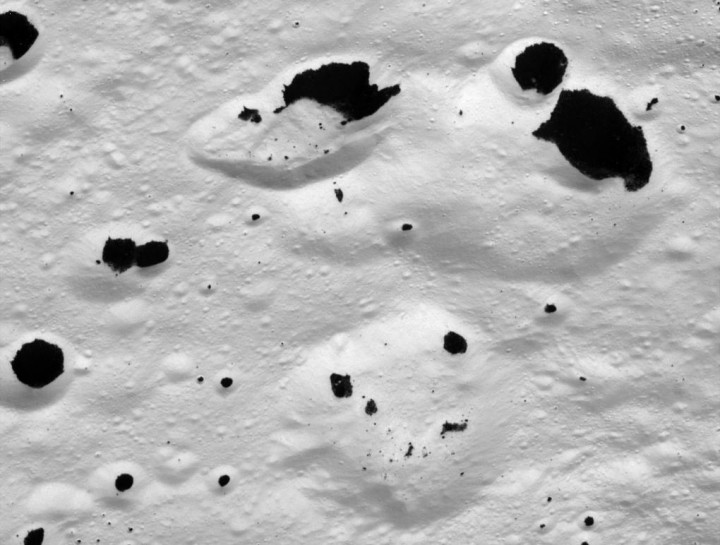 Iapetus in Black and White Credit: Cassini Imaging Team, SSI, JPL, ESA, NASA Explanation: Iapetus, Saturn's third largest moon, is a candidate for the strangest moon of Saturn. Tidally locked in its orbit around the ringed gas giant, Iapetus is sometimes called the yin-yang moon because its leading hemisphere is very dark, reflecting about 5 percent of the Sun's light, while its trailing hemisphere is almost as bright as snow. This recent Cassini spacecraft flyby image is one of the closest views ever and spans about 35 kilometers across a cratered transition zone between bright and dark terrain. Iapetus itself has a density close to that of water ice, but the detailed reflective properties of the dark material suggest an organic composition. Honoring the moon's discoverer, the dark terrain is called Cassini Regio. Tomorrow's picture: stereo Saturday Πηγή
__________________
όταν γράφεται η ιστορία της ζωής σου, μην αφήνεις κανέναν να κρατάει την πένα |
 |
#231
|
 |
|
||||
 Iapetus: 3D Equatorial Ridge Credit: Cassini Imaging Team, SSI, JPL, ESA, NASA Stereo Anaglyph: Patrick Vantuyne Explanation: This bizarre, equatorial ridge extending across and beyond the dark, leading hemisphere of Iapetus gives the two-toned Saturnian moon a distinct walnut shape. With red/blue glasses you can check out a remarkable stereo composition of this extraordinary feature -- based on close-up images from this week's Cassini spacecraft flyby. In fact, the ridge's combination of equatorial symmetry and scale, about 20 kilometers wide and reaching up to 20 kilometers above the surface, is not known to be duplicated anywhere else in our solar system. The unique feature was discovered in Cassini images from 2004. It appears to be heavily cratered and therefore ancient, but the origin of the equatorial ridge on Iapetus remains a mystery. Tomorrow's picture: above it all Πηγή
__________________
όταν γράφεται η ιστορία της ζωής σου, μην αφήνεις κανέναν να κρατάει την πένα |
 |
#232
|
 |
 |
#233
|
 |
|
||||
  Οκ, ασ' το πάνω μου! Οκ, ασ' το πάνω μου! 
__________________
Δε χάνεται η ελπίδα τελευταία... Τελευταία χάνεται η ψυχή όταν χάσει την ελπίδα της... |
 |
#234
|
 |
|
||||
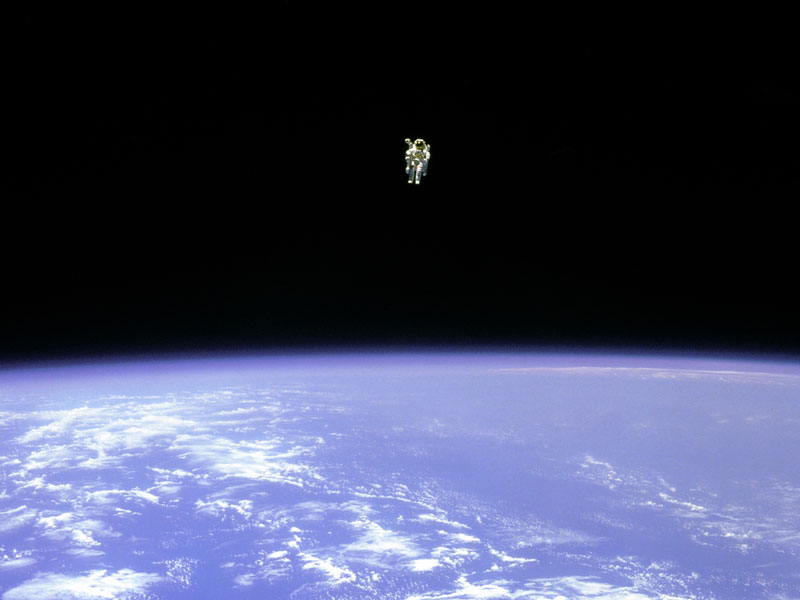 To Fly Free in Space Credit: STS-41B, NASA Explanation: At about 100 meters from the cargo bay of the space shuttle Challenger, Bruce McCandless II was further out than anyone had ever been before. Guided by a Manned Maneuvering Unit (MMU), astronaut McCandless, pictured above, was floating free in space. McCandless and fellow NASA astronaut Robert Stewart were the first to experience such an "untethered space walk" during Space Shuttle mission 41-B in 1984. The MMU works by shooting jets of nitrogen and has since been used to help deploy and retrieve satellites. With a mass over 140 kilograms, an MMU is heavy on Earth, but, like everything, is weightless when drifting in orbit. The MMU was replaced with the SAFER backpack propulsion unit. Tomorrow's picture: victoria of mars Πηγή
__________________
όταν γράφεται η ιστορία της ζωής σου, μην αφήνεις κανέναν να κρατάει την πένα |
 |
#235
|
 |
|
||||
|
ουαου! τι ωραια που ειναι!
__________________
πρεπει οπωσδηποτε να βαλω υπογραφη?? 
|
 |
#236
|
 |
|
||||
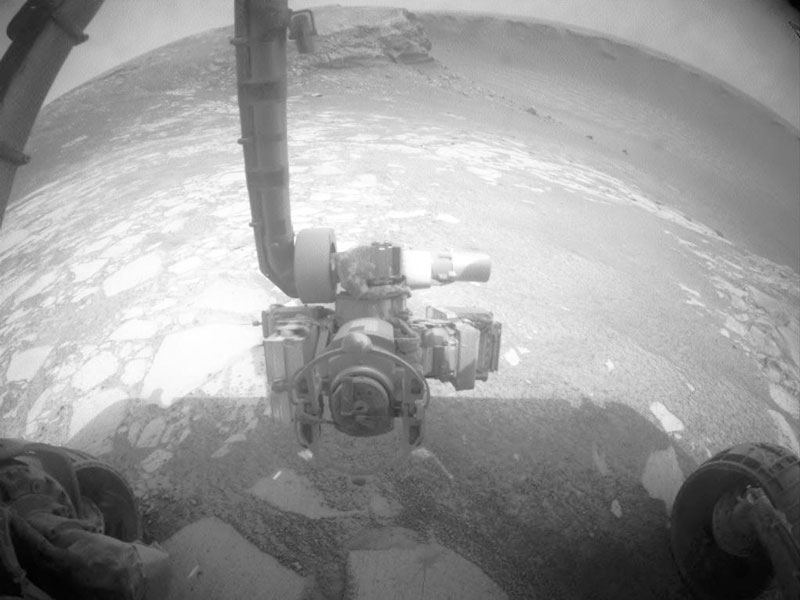 nside Victoria Crater on Mars Credit: Mars Exploration Rover Mission, Cornell, JPL, NASA Explanation: NASA's Opportunity rover is now inside Victoria Crater on Mars. Last week the robot rolled about 20 meters into the largest crater any Martian rover has yet encountered, the crater next to which Opportunity has been perched for months. Currently, the rolling explorer is situated in Duck Bay alcove, peering across at the internal crater wall dubbed Cape St. Vincent. The above wide-angle view is from Opportunity's front hazard-identification camera. Over the next few weeks, Opportunity is scheduled to explore this telling alien indentation, searching for clues to the ancient past of Mars before the huge impact that created Victoria Crater ever took place. Tomorrow's picture: road to milky way Πηγή
__________________
όταν γράφεται η ιστορία της ζωής σου, μην αφήνεις κανέναν να κρατάει την πένα |
 |
#237
|
 |
|
||||
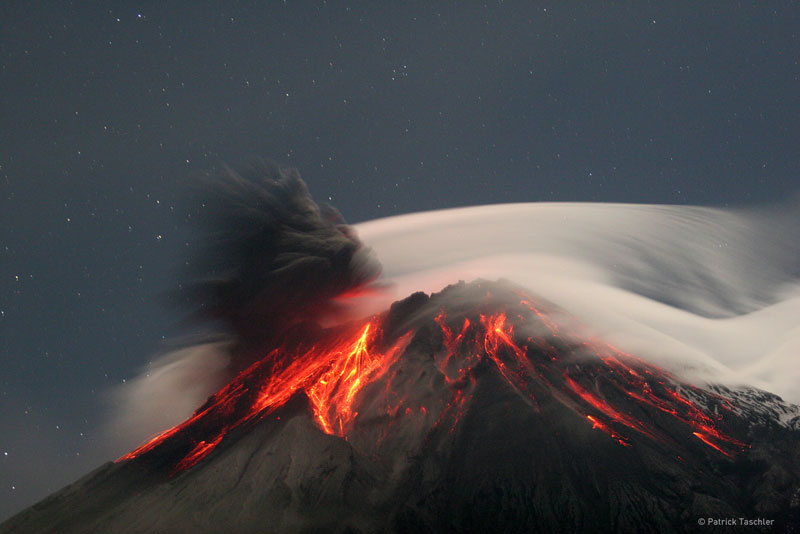 Tungurahua Erupts Credit & Copyright: Patrick Taschler Explanation: Volcano Tungurahua erupted spectacularly last year. Pictured above, molten rock so hot it glows visibly pours down the sides of the 5,000-meter high Tungurahua, while a cloud of dark ash is seen being ejected toward the left. Wispy white clouds flow around the lava-lit peak, while a star-lit sky shines in the distance. The above image was captured last year as ash fell around the adventurous photographer. Located in Ecuador, Tungurahua has become active roughly every 90 years since for the last 1,300 years. Volcano Tungurahua has started erupting again this year and continues erupting at a lower lever even today. APOD editor to review best space pictures in Philadelphia next Wednesday Tomorrow's picture: saturn drops Πηγή
__________________
όταν γράφεται η ιστορία της ζωής σου, μην αφήνεις κανέναν να κρατάει την πένα |
 |
#238
|
 |
|
||||
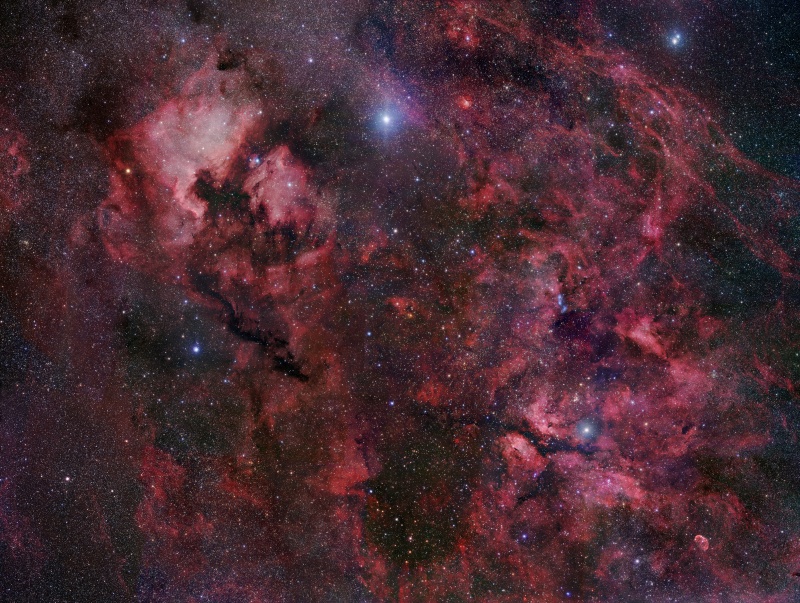 Northern Cygnus Credit & Copyright: Robert Gendler Explanation: Bright, hot, supergiant star Deneb lies at top center in this gorgeous skyscape. The 20 frame mosaic spans an impressive 12 degrees across the northern end of Cygnus the Swan. Crowded with stars and luminous gas clouds along the plane of our Milky Way Galaxy, Cygnus is also home to the dark, obscuring Northern Coal Sack Nebula, extending from Deneb toward the bottom center of the view. The reddish glow of NGC 7000, the North America Nebula, and IC 5070, the Pelican Nebula, are at the upper left, but many other nebulae and star clusters are identifiable throughout the wide field. Of course, Deneb itself is the alpha star of Cygnus and is also known to northern hemisphere skygazers for its place in two asterisms -- marking the top of the Northern Cross and a vertex of the Summer Triangle. Tomorrow's picture: kind hearts and coronets Πηγή
__________________
όταν γράφεται η ιστορία της ζωής σου, μην αφήνεις κανέναν να κρατάει την πένα |
 |
#239
|
 |
|
||||
 oronet in the Southern Crown Credit: X-ray: NASA/ CXC/CfA/ J.Forbrich et al.; Infrared: NASA/ SSC/CfA/IRAC GTO Team Explanation: X-rays from young stars and infrared light from stars and cosmic dust are combined in this false color image of a star-forming region in Corona Australis, the Southern Crown. The small star grouping is fittingly known as the Coronet Cluster. A mere 420 light-years distant, the Coronet Cluster offers a relatively close-up view of stars and protostars evolving with a wide range of masses. The observations suggest that energetic x-rays come from the hot, extended stellar atmospheres or coronae of the Coronet stars. The tantalizing multi-wavelength view spans about 2 light-years and was produced using data from the orbiting Chandra Observatory (x-ray) and the Spitzer Space Telescope (infrared). Tomorrow's picture: light-weekend Πηγή
__________________
όταν γράφεται η ιστορία της ζωής σου, μην αφήνεις κανέναν να κρατάει την πένα |
 |
#240
|
 |
|
||||
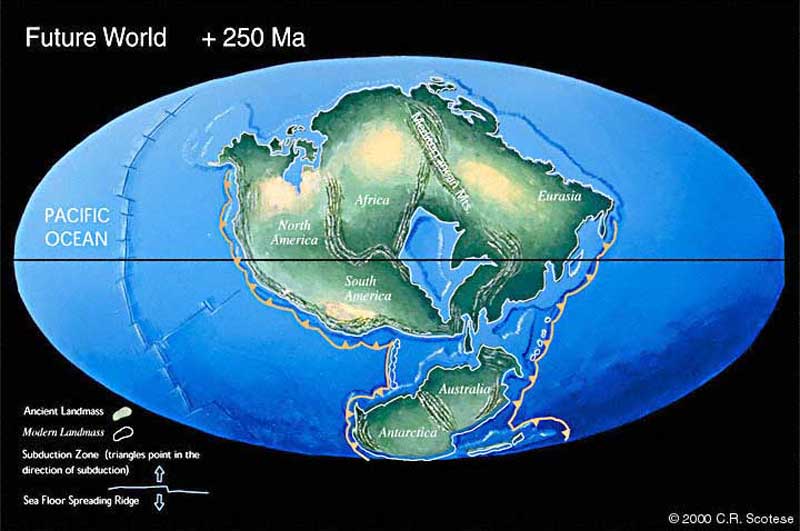 Pangea Ultima: Earth in 250 Million Years? Credit & Copyright: C. R. Scotese (U. Texas at Arlington), PALEOMAP Explanation: Is this what will become of the Earth's surface? The surface of the Earth is broken up into several large plates that are slowly shifting. About 250 million years ago, the plates on which the present-day continents rest were positioned quite differently, so that all the landmasses were clustered together in one supercontinent now dubbed Pangea. About 250 million years from now, the plates are again projected to reposition themselves so that a single landmass dominates. The above simulation from the PALEAOMAP Project shows this giant landmass: Pangea Ultima. At that time, the Atlantic Ocean will be just a distant memory, and whatever beings inhabit Earth will be able to walk from North America to Africa. APOD editor to review best space pictures in Philadelphia on Wednesday Tomorrow's picture: day = night Σχόλιο : Απίστευτο; Η γη επιστρέφει στην αρχική της θέση. Ψιτ ας βρει κάποιος την μηχανη του χρόνου να κάνω μια πτήση με διαστημόπλοιο να δω αυτό το θέαμα.
__________________
όταν γράφεται η ιστορία της ζωής σου, μην αφήνεις κανέναν να κρατάει την πένα |
 |
| Συνδεδεμένοι χρήστες που διαβάζουν αυτό το θέμα: 5 (0 μέλη και 5 επισκέπτες) | |
| Εργαλεία Θεμάτων | |
| Τρόποι εμφάνισης | |
|
|